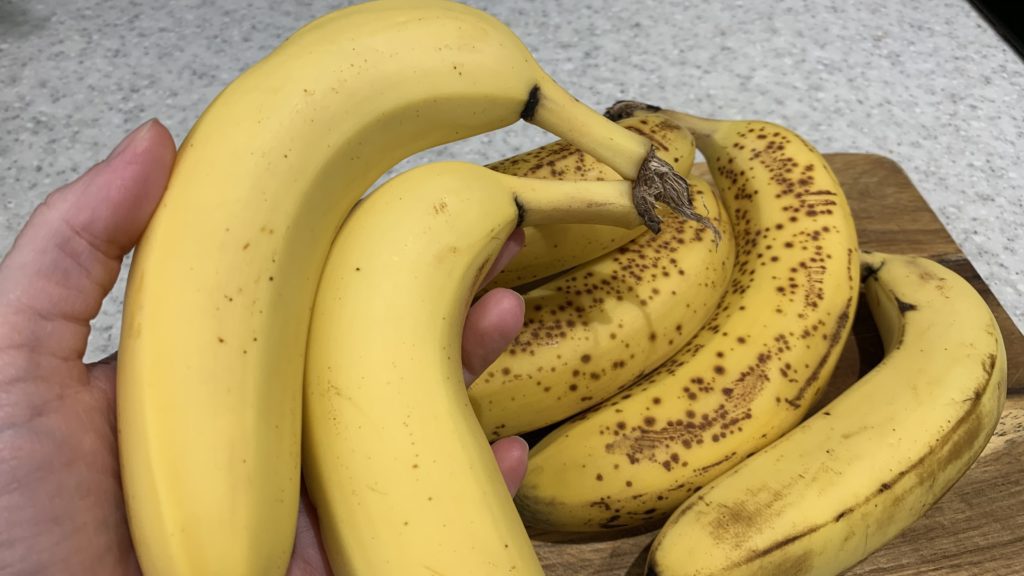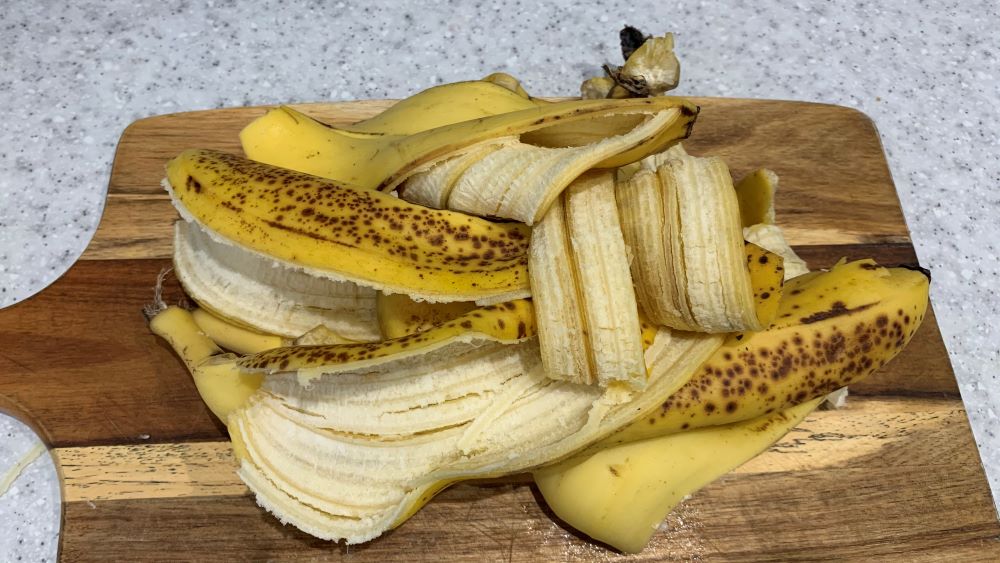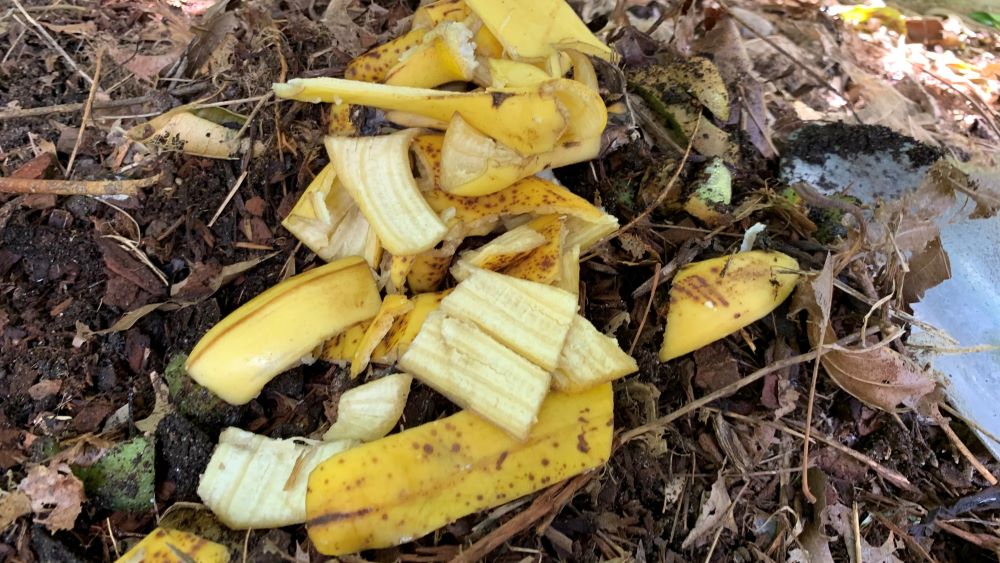Banana peels are a great ingredient for your compost adding potassium, magnesium and iron. Add them to your compost as whole peels or snip them into small pieces with your kitchen scissors. Cutting them up into small pieces will help them to break down quicker and avoid attracting vinegar flies.
This article will explore how to compost banana peels to help them to break down quickly, feed the soil bacteria and worms and turn into nutrient rich humus for your garden.

How to compost banana peels
Here are easy steps to compost banana peels at home and quickly turn them into dark humus for your garden. These tips will help to keep pests away and avoid the banana peels becoming smelly.
1. Peel your bananas

The first step is to collect your banana peels. If you are like me and freeze bananas for smoothies you can end up with lots of banana peel in one go. Most compost piles can keep their balance with the addition of 4-5 banana peels per week.
If you have too many banana peels to add to your compost then you can freeze the skins in a ziplock back for a later date.
You can also add banana peels to your worm farm. For more on this, check out my article here: How to put banana peels in a worm farm | Easy tips to avoid flies
2. Bring the peel outside straight away

Banana peels will turn black quickly so I like to bring mine out to my compost pile straight away. This will mean that they won’t go black in my compost bin inside. If you have a compost container with a tight fitting lid then you can store the peels for 1-2 days. Just keep the lid on tightly to avoid attracting vinegar flies.
3. Cut the banana peels into small pieces

To help the banana peels to break down as quick as possible it is best to cut them into smaller pieces. I like to use kitchen scissors to snip them into pieces that are ½ an inch wide. This helps the banana skins to break down as quickly as 2-3 weeks in my small compost pile.
You can also chop them up with a kitchen knife inside after peeling the bananas or just break each peel pieces off from the base. This means you will end up with 4-5 longer pieces of banana that will still break down quicker than a fully connected skin.

Note: you can add whole bananas to your compost bin and they will break down in 3-4 weeks. The risk is that they will attract flies or ants before they fully break down.
4. Cover the banana peels with brown material

After adding the banana peel pieces to the top of your compost bin it is important to cover them over with brown material like hay or fall leaves. This will help to absorb some of the moisture from the banana skins and help to deter flies and ants.
You can also dig the banana skins into the compost with a garden fork or compost mixer. This will also help the banana peels to break down quicker because they will have more contact with the soil bacteria and the worms in your compost.

5. Add other ingredients to keep the pH balance
Banana peels are slightly acidic with a pH of around 5 so it is a good idea to mix them into your compost with other food scraps like corn husks, carrot peelings and cabbage leaves. A mix of ingredients will help to balance the pH and add a range of nutrients.
You can sprinkle on a handful of garden lime in spring and summer to help to reduce the acidity of the compost pile. This will help to keep away vinegar flies that are attracted to the acidic fruit when it breaks down.
Benefits of composting banana peels
Banana peels offer lots of benefits to your compost pile and eventually to your garden soil. Here are some of my favorite benefits of composting banana peels at home.
1. Add valuable nutrients to your compost and soil
Banana peels contain a range of nutrients including potassium, nitrogen, magnesium and phosphorus as well as carbon. All of these will be broken down and mixed into your compost and then your soil. Use the compost as a top dressing around the root zone of established trees or shrubs or mix it into your vegetable garden before planting your next crop.
2. Reduce on landfill
Composting banana peels is a great way to avoid letting them end up in landfill. Save on waste and turn them into compost instead.
3. Increase the organic matter in your soil
Turning banana peels into compost is a great way to add extra organic matter to your soil. This will help to aerate the soil allowing roots to grow wide and strong. Adding compost will help the soil to hold water for longer helping your plants to tolerate longer dry spells and keeping the soil bacteria population healthy.
4. Feed the worms
Adding compost to your soil will help to feed the worms in your garden. Worms will feed on any unbroken down organic matter left when you mix the compost into your soil. They will eat any brown materials leftover like fall leaves or any banana peel that may not have broken down completely.
Can you just throw banana peels straight onto garden soil?
Banana peels will take longer to break down if they are added straight on top of garden soil instead of being broken down in a compost pile.
While burying banana peels are unlikely to cause harm to your plants they can stay in the soil for a long time before they are completely broken down. This process is not as beneficial as quickly turning them into compost in your compost bin with other ingredients like a mix of food scraps, coffee grounds and dry brown materials.
How to compost banana peels | Summary
Banana peels will break down quickly in compost bins or piles if they are chopped into small pieces and mixed in with other food scraps. Add brown materials like straw and fall leaves to absorb the extra water and help to deter flies and ants.
Banana peels will add valuable potassium to your soil helping plants to grow fruit and flowers.
Happy composting.
I am an accredited practicing dietitian, experienced gardener and a dedicated cook. I love writing and sharing my experience so you can learn from my successes and mistakes.
